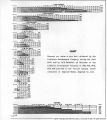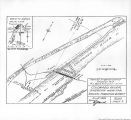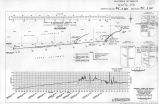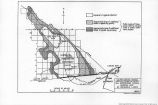| OCR Text |
Show THE ALLr AMERICAN CANAL. 75 the east-side high-line canal it again approaches the boundary and follows along it to the west-side main canal, except for a detour in order to get around the city of Calexico, and to obtain a better crossing of New River. The general map of the all-American canal (Exhibit A) shows the location of the canal from Laguna Dam to the west-side main canal. The map shows the approximate location of canal structures and other prominent features adjacent to the line. (b) Throughout the blow-sand areas two alternate routes were surveyed, one along the boundary, which is about If miles shorter than the line above described but contains 1,800,000 cubic yards more excavation. The second, to the north of the adopted line, was surveyed for the purpose of avoiding the first big sand ridges described above. This line is about one-half mile longer, but contains 200,000 cubic yards less excavation (see Exhibit A). (c) Topography was completed and extended on the section south of Pilot Knob, and a strip of topography 2,000 feet in width was taken on the lines through the sand hills. Additional topography was taken at Laguna Dam, along the Southern Pacific tracks near Araz, Alamo River, and New River crossings. (d) All the topography taken and available was plotted on a scale of 400 feet to the inch. This is shown on 37 sheets which are on file in the Yuma office. A profile of the canal from Siphon Drop to the west-side main canal on a scale of 500 feet to the inch is also on file in the Yuma office. IRRIGABLE ACREAGE. (a) The irrigable acreage of the Imperial Irrigation District now within the district boundaries is about 515,000 acres, all of which can be reached by gravity through an all-American canal, with the exception of two or three sections near the international boundary west of New River, upon which it will be necessary to pump the water. The west-side main canal can be made to serve another possible 40,000 acres. (&) In the east-side mesa district there is estimated to be 140,000 acres, and to the north of the Southern Pacific Railroad, east and north of the Salton Sea, including the Coachella Valley there is another 200,000 acres, making a total of 895,000 acres that can be served by a gravity system. (c) In consultation with the board of engineers, it was decided to adopt 900,000 acres as the basis upon which to make the estimates. WATER DUTY. (a) In designing the capacity of a canal to serve 900,000 acres of land the maximum amounts required and the canal losses are the main factors to be considered. A study of the water deliveries on the |
| Source |
Original book: [State of Arizona, complainant v. State of California, Palo Verde Irrigation District, Coachella Valley County Water District, Metropolitan Water District of Southern California, City of Los Angeles, California, City of San Diego, California, and County of San Diego, California, defendants, United States of America, State of Nevada, State of New Mexico, State of Utah, interveners] : California exhibits. |




































































































































































































































































































































































































